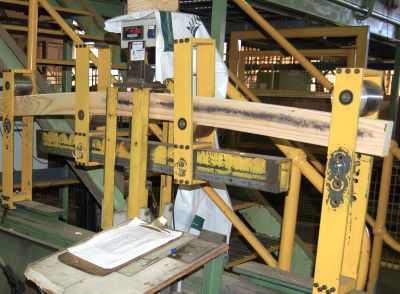Strength groups

What is strength? We discussed this issue in the earlier lesson Strength (in Section 2: Wood properties).
You should go back and revise this lesson now if you need to refresh your memory on the details.
Other lessons that you may also want to revise include: Density, The drying process and Softwoods and hardwoods.
In structural timber grading, the term strength generally refers to bending strength, which is a very important property for building timbers that need to withstand heavy loads.
One way of classifying different species of timber according to their relative strength is to divide them into strength groups. Since most species become stronger when they’re seasoned, there are two sets of strength groups:
-
one for green timbers, ranging from S1 (the strongest) to S7
-
one for dry timbers, ranging from SD1 (S for strength, D for dry) to SD8.
You can see from the list below of common building timbers that the density of a species has a big influence on its strength. This is because density is closely related to the thickness of the cell walls in the wood fibres. The right hand column shows the density, either green (GD) or air dried (ADD) measured at an average of 12% MC.
| Example of timber species | Strength group (unseasoned) | Green density (GD) | Strength group (seasoned) | Air dried density (ADD) |
| Grey ironbark (Eucalyptus paniculata) | S1 | 1250 | SD1 | 1100 |
| Blackbutt (Eucalyptus pilularis) | S2 | 1150 | SD2 | 900 |
| Messmate (Eucalyptus oblique) | S3 | 1100 | SD3 | 750 |
| Jarrah (Eucalyptus marginata) | S4 | 1100 | SD4 | 800 |
| Douglas fir (oregon) (Pseud. menziesii) | S5 | 710 | SD5 | 550 |
| Radiata pine (Pinus radiata) | S6 | 800 | SD6 | 550 |
| Light-red meranti (Shorea spp.) | S6 | – | SD7 | 400 |
| Western red cedar (Thuja plicata) | S7 | – | SD8 | 350 |
Strength group classifications are the basis for the traditional F grade system that has been used for many years to grade structural timber. However, as we’ll see in the next lesson, the relationship between strength groups and F grades is not always as predictable as it was once thought. More modern methods of testing timber strength have led to revisions in the F grades used for particular species, including radiata pine.
Nonetheless, it’s still important to understand the relationship between strength groups, structural grades and stress grades, especially if you’re involved in visual stress grading, because it’s still central to the way the grading rules are written up in the Australian Standards.